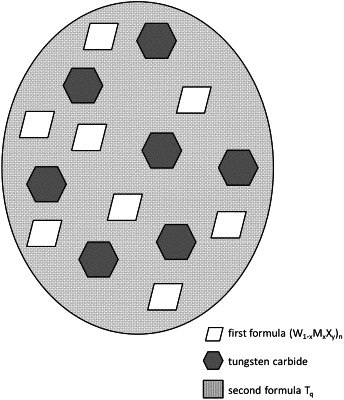| CPC C22C 29/14 (2013.01) [B24D 18/0009 (2013.01); C22C 1/051 (2013.01); C22C 1/1084 (2013.01); C22C 29/08 (2013.01); C22C 32/0005 (2013.01); C22C 33/0292 (2013.01)] | 20 Claims |

|
1. A method of preparing a composite matrix, comprising:
a) blending together a first composition having a formula (W1-xMxXy)n, a tungsten carbide composition of formula (WC0.99-1.05)p, and a second composition of formula Tq for a time sufficient to produce a powder mixture;
wherein:
X is one of B, Be and Si;
M is at least one of titanium (Ti), vanadium (V), chromium (Cr), manganese (Mn), iron (Fe), cobalt (Co), nickel (Ni), copper (Cu), zinc (Zn), zirconium (Zr), niobium (Nb), molybdenum (Mo), ruthenium (Ru), hafnium (Hf), tantalum (Ta), rhenium (Re), osmium (Os), iridium (Ir), lithium (Li), yttrium (Y) and aluminum (Al);
T is an alloy comprising at least one Group 4, 5, 6, 7, 8, 9, 10, 11, 12, 13, or 14 element in a Periodic Table of Elements;
x is from 0 to 0.999;
y is at least 4.0;
p, q, and n are each independently from 0.01 to 0.99;
p, q, and n have a sum of 1; and
wherein p, q and n are weight percentage ranges;
b) pressing the powder mixture under a pressure sufficient to generate a pellet; and
c) sintering the pellet at a temperature sufficient to produce a densified composite matrix;
wherein the composite matrix has a fracture toughness of at least about 1 to 25 MPa m1/2 as determined using the Palmquist method; and
wherein the composite matrix has a hardness of at least about 1 to 40 GPa as determined by Vickers hardness under a force of 294N (HV30).
|